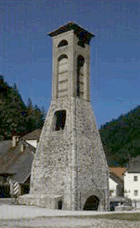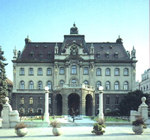
Chemistry International
Vol. 22, No.3, May 2000
2000, Vol. 22
No. 3 (May)
..Chemistry in Slovenia
..News from IUPAC
..Reports from Symposia
..New Projects
..New Books
..Letter to the Editor
..Reports from Commissions
..Provisional Recommendations
..Conference Announcements
..Conferences
Download the May
issue in pdf format.
(932K)
Download the May
cover in pdf format.
(58K)
Chemistry International
Vol. 22, No. 3
May 2000
Chemistry in Solvenia Reflects Rich History and Advances in Both Industry and Education
This article was contributed by Prof. Venceslav Kaucic (National Institute of Chemistry and University of Lujbljana, P.O. Box 3430, SI-1001 Ljubljana, Slovenia; E-mail: [email protected]), President of the Slovenian Chemical Society, together with Dr. Roman Gabrovsek (National Institute of Chemistry, P.O. Box 3430, SI-1001 Ljubljana, Slovenia; E-mail: roman.gabrovsek@ ki.si), Research Associate, and Dr. Edvard Kobal (Slovenian Science Foundation, Stefanova 15, SI-1000 Ljubljana, Slovenia; E-mail: edvard.kobal@ ustanova-szf.si), Director of the Slovenian Science Foundation.
Introduction
Chemistry in Pre-20th Century Slovenia
Early 20 th Century Slovenian Chemistry
Postwar Chemistry in Slovenia
University Study
Research Work–Its Development, Importance, and Achievements
Establishment, Role, and Status of the Slovenian Chemical Society
Slovenian Chemical DaysSlovenia’s geographic and demographic area has witnessed an extraordinarily rich development of chemical knowledge, education, industry, and use of chemicals and chemical products, mainly because the region that is now Slovenia has been, throughout history, an active crossroads of different economic paths, interests, areas, specific features, and problems.
This article surveys the beginning, development, and present status of chemistry in Slovenia, encompassing the general evolution of both the chemical industry and chemical education as they have developed and grown. Slovenia is a young Central European country; it declared its independence on 25 June 1991 after the breakup of Yugoslavia. Slovenia occupies an area of 20 256 km 2 and has 2 million inhabitants. The country is situated at the crossroads of four distinct geographical regions: the Alps to the north, the Pannonian plain to the northeast, the Dinaric mountain chain to the south-east, and the Adriatic coast to the south. European Union countries recognized Slovenia as an independent, sovereign state on 15 January 1992. Slovenia has been a permanent member of the United Nations since 22 May 1992, and on 6 March 1995, the European Community’s Council of Ministers granted a mandate for the beginning of negotiations on the association agreement between the European Union and Slovenia.
Chemistry in Pre-20th Century Slovenia
The earliest known Slovenian document, entitled The Freising Fragments and written in Latin script, appeared about 1000 A.D., but it was not until the 17 th century that the first written text having chemistry as its subject appeared.
In the 14 th and 15 th centuries, as the humanist movement spread across Europe, a number of thinkers, professors, doctors, and educators of Slovenian origin were active in European universities, courts, or in diplomatic services. They were also acting as contributors in spreading information about the historical, cultural, and demographic heritage of the Slovenian nation well outside of its geographic borders.
In 1490, mercury was discovered in the town of Idrija, and the place soon became the second biggest mercury mine in the world (after Almaden in Spain). The discovery of mercury sparked considerable development of science and technology; Paracelsus, having visited the site of the mine in the early 16 th century, started to exploit mercury systematically as a medicine. Scientists, mainly geologists and physicians, frequently worked in the area from the second half of the 18 th century on, and they communicated their findings about
Geographical position of Slovenia in Europe.its geological and technological features throughout Europe. As a consequence of these intensive investigations, a School of Metallurgy and Chemistry was established in Idrija in 1769. (The school contributed significantly to the advancement and use of modern geo-logical approaches to mining for the next 200 years. After World War II, geologist Ivan Mlakar made a highly original study of the complicated geological deposits of Idrija and established the internationally renowned Idrijan Geological School.)
Chemical education in Slovenia was at that time at its very beginning. The first teacher of chemistry was Baltazar Hacquet, who worked from 1782 to 1787 at the Medico-Surgery Lycée in Ljubljana. At the beginning of the 19 th century, chemistry became one of the subjects taught at the Central School (renamed the Academy in 1811) in Ljubljana. Through the end of the 19 th century, chemical education prospered further. Textbooks were issued; systematic chemical education was established; and papers on chemical elements, their symbols, and properties appeared. In 1898, the Agricultural- Chemical Experiment Station was built.
An old-fashioned iron smelting furnace from the north-western, ore-rich region of Slovenia, where metallurgy had been in use from the 14 th century to the beginning of the 20th century.
During the 19 th century, other notable discoveries and advances were connected with the Slovenian region. Jozef Stefan, director of the Physics Institute in Vienna, Austria, discovered the law of radiation, and Austrian geographer Adolf Schmidl established speleology as a new scientific discipline on the basis of his research on phenomena in Slovenian karst caves. The most important karst topography phenomena include formation of sinkholes and caves in the barren, rocky limestone-based ground; presence of underground rivers; appearance and/or disappearance of surface streams; and absence of permanent surface rivers, streams, and lakes.
During the 19 th century, chemical industry witnessed its first stage of industrialization without much significant growth or expansion. It produced mostly basic chemical products, among them soaps, candles, sulfuric acid, and potassium nitrate; there were also some refineries for mineral oils. There were specific factories producing synthetic resins; lacquers and paints (Color, Medvode); zinc from zinc ore (Cinkarna, Celje); black powder (the chemical industry of Kamnik); coatings (Jub, Dol near Ljubljana); and washing powder, cleaning agents, and cosmetics (Zlatorog, Maribor; now Henkel Slovenija).
Early 20 th Century Slovenian Chemistry
Chemical Industry
Before the beginning of World War I, several chemical industry factories had been built for production of aluminum oxide (Kemicna tovarna Moste), cosmetics, cleaning agents and candles (Ilirija-Vedrog, Ljubljana), and for food processing and production (Kolinska, Ljubljana). In the era between the two world wars, the Slovenian chemical industry experienced a rapid period of growth. During this expansion, factories were established for the production of carbides, ferroalloys, and synthetic fertilizers (Tovarna dusika Ruse); rubber, leather, and chemical products (Sava, Kranj); chemical, graphics, and paper industry (Aero, Celje); and insulating materials (Izolirka, Ljubljana). The beginning of World War II put an end to the expansion and growth of the chemical industry in Slovenia. The majority of factories were taken over by the German army, and their industrial processes were channeled into the manufacture of military-specific products.
Chemical Education
In 1910, the first chemistry textbook in the Slovenian language, Chemistry and Mineralogy by Baltasar Baebler, was printed.
The main building of the
University of Ljubljana,
erected in 1902.
In 1919, the University in Ljubljana was established. The first professors of chemistry at the university were Maks Samec and Marius Rebek. They started lecturing in 1919—1920 at the newly established Institute of Chemistry. Maks Samec was a well-known chemistry teacher and the author of three German-language books and one English-language monograph on colloid chemistry of starch and cellulose.
After the end of World War II, most of the industrial infrastructure of Slovenia needed considerable repair and/or modernization. In addition, new factories were built, mostly in the areas of fertilizers, pesticides, specialty chemicals, melamine- and urea-based resins, hydrogen peroxide and sodium perborate, surface protection coatings, and special additives for the textile and leather industries. The two largest pharmaceutical companies, Lek (Ljubljana) and Krka (Novo mesto), were also built during this period, in 1946 and 1954, respectively. The economy, and especially the chemical industry, developed rapidly, assuming in the mid-1950s an entirely new appearance and reaching for new markets. The chemical industry as a whole became a leading branch of the economy.
From the 1950s on, more new factories were built, including those for production of organic acids, synthetic fibers, plastics, adhesives, and cement. According to 1997 data from the Chamber of Commerce and Industry of Slovenia, the chemical and rubber industry represented 14.9% of the total Slovenian industrial turnover, 9.8% of the total industrial labor force was employed in the chemical and rubber industry, and their contribution to the added value of Slovenian industry amounted to 18.2%.
[More]
News
and Notices - Organizations and People
- Standing Committees
Divisions
- Projects - Reports
- Publications - Symposia
- AMP - Links
Page last modified 14 April 2000.
Copyright © 1997-2000 International Union of Pure and Applied Chemistry.
Questions or comments about IUPAC, please
contact the Secretariat.
Questions regarding the website, please contact [email protected]



